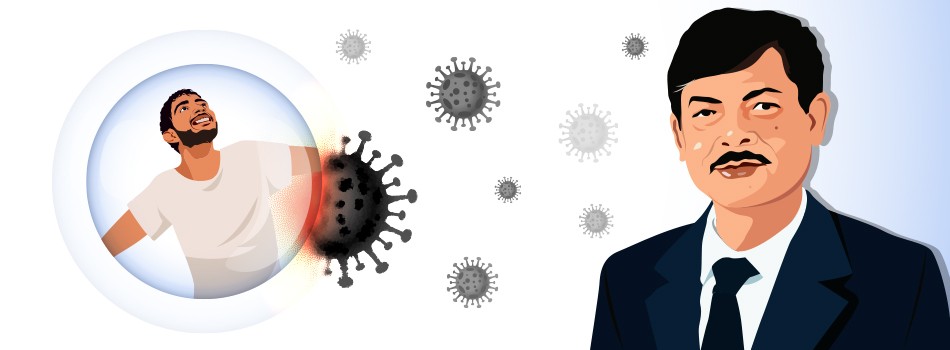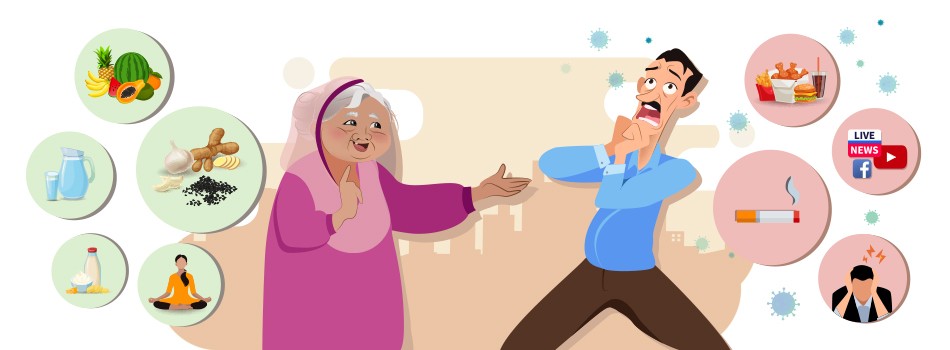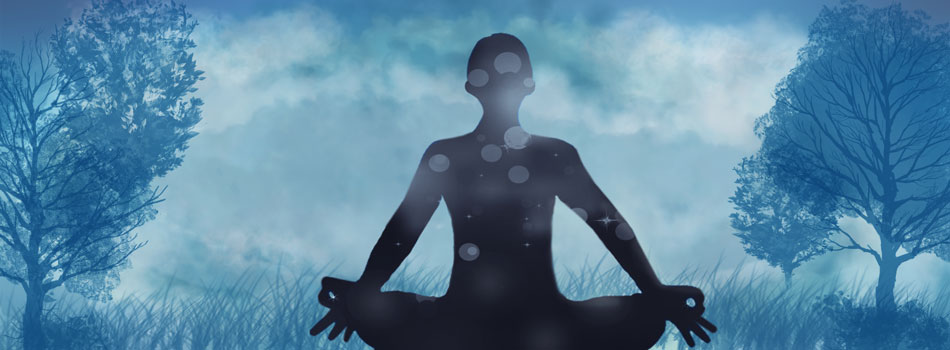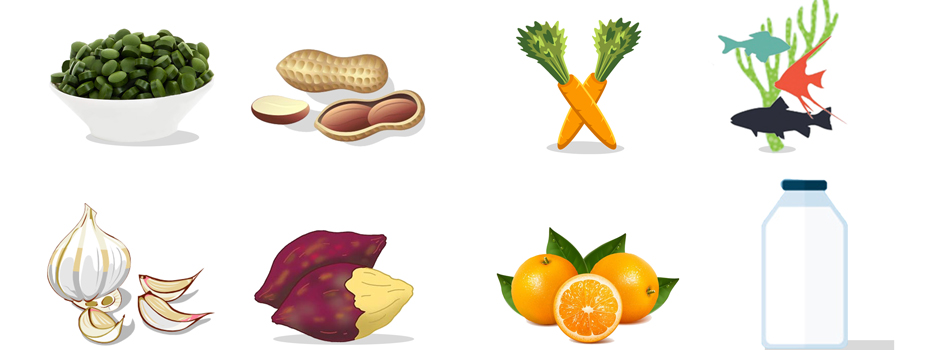
Immune system: the central player in the fight against COVID-19
published : 30 May 2020
1.
On March 11, 2020, the World Health Organization (WHO) declared the coronavirus outbreak a global pandemic as the virus rapidly spread across the world from China. Bangladesh announced the first confirmed coronavirus cases in the country on March 8, 2020. This virus was unknown to the world until the Chinese authorities notified at the end of December 2019 that a deadly virus spread through their communities. On February 11, the International Committee on Taxonomy of Viruses announced the virus name as ‘SARS-CoV-2’ (Severe Acute Respiratory Syndrome Coronavirus 2) and WHO announced ‘COVID-19’ (Coronavirus Disease 2019) as the name of this virus-mediated disease.
The coronavirus pandemic has created a tremendous threat to global health and wellbeing. While writing of this article is in progress, the highly contagious virus caused illness in more than 6 million people from as many as 213 countries around the globe. This illness caused deaths of almost 370 thousand individuals globally. Needless to say that this huge death spread panic to all. The number of cases is still rising exponentially in many countries including Bangladesh. Like others, our government has also taken various measures to deal with this alarming situation. To minimize the spread of the virus and the deaths caused by it, the government imposed various restrictions including mass-closures, shutdowns and social distancing. Unfortunately, all these restrictions were frequently violated by many. The recent announcement of opening restaurants and shopping malls just added fuel to the flame. The virus spread quickly, and the number of positive cases kept increasing alarmingly that fuels the fear further.
The fear generated by the virus is addressed well so far, however, the role of the body's immune system in combating the virus is not discussed with equal extent. Some people infected with SARS-CoV-2 is observed to become severely ill, while most others (>80%) do not. It is not known exactly why some people develop life-threatening illness while others remain asymptomatic. It may, however, be linked with individual’s immune status, which can be strong or weak depending on the type, amount and the route by which the virus enters the body. The immune system, as is known, played a vital role for overcoming all the past pandemic occurrences in the history by humans when vaccines were not available. Therefore, until and unless we have an effective vaccine to overcome the present pandemic, the central player in fighting against the novel coronavirus would be our immune system. It would protect us against the deadly invader and can even be helpful as potential therapy.
2.
The virus usually enters the body with respiratory droplets through the nose or mouth and contacts with cells in the lining of the nose or in the area of lungs. To infect, the virus attaches itself to a cell involving its spike protein. The spike protein binds to the cell’s matching receptor, called angiotensin converting enzyme 2 (ACE-2), expressed normally on the lungs, heart and gut cell surfaces. The virus then injects its genetic material and hijacks the cell’s machinery to make more of its copies and release them for further infection. The body's immune system, however, does not let it go unchallenged. Shortly after the viral attack, the body's immune system starts operation with its soldier-like cells equipped with various armaments. The soldier cells that come forward first for the battle are mainly granulocytes, macrophages and natural killer (NK) cells. These cells take part in an operation, known as innate immune response, in which they mainly fight SARS-CoV-2 using toxic enzymes, interferons (secreted by infected cells) and other potential signalling molecules. NK cells particularly kill virally infected cells after specifically recognizing stress proteins expressed on their cell surface. The innate immunity plays a key role to prevent the virus from replicating too widely. The symptoms of COVID-19, therefore, remain mostly unnoticed in majority of the population.
On the other hand, SARS-CoV-2 use various tricks to bypass and evade the immune system's defensive operations. Even after bypassing these operations the virus is not out of danger. After a time delay, it faces a second wave of defensive operations—known as the adaptive immune response. While infection goes further, cytotoxic T-cells get expanded. These cells patrol to look for virally infected cells, and once it finds one it typically latches on and fires toxic molecules that punch through the infected cell's membrane. As a result, the infected cell together with its reserves of virus is destroyed. B cells, on the other hand, form antibodies that can keep the virus in check by binding its spike protein specifically. The virus loses its infectivity after its spike proteins are masked with antibodies. Our immune system also memorizes the invader, and if become re-infected with the same pathogen it would produce antibodies quickly to restrict that pathogen.
3.
The total infected cases in Bangladesh so far is around 43 thousand and total deaths around 600. Total cases of our neighbour India and Pakistan are 174 thousand and 67 thousand; and deaths are 5,000 and 1,400, respectively. Compared to these figures, the rates of both infection and death is quite high in USA, where cases are more than 17 lacs and deaths more than 1 lac. European countries like Spain, Italy, UK and France each also has cases around 2-3 lacs and deaths around 27,000-38,000. Strikingly, the overcrowded subcontinental countries including Bangladesh are getting incredibly fewer positive cases and fatality.
This fewer fatality cases, no doubt, relieved much of our fear and mental stress. However, it also raised a question why should the developed countries have a far greater number of COVID cases than the poor and overcrowded subcontinental countries? It is hard to answer this question logically as the subcontinental countries are far behind in their resources and health care facilities compared to those countries. We understand that more aggressive testing could result in more positive COVID-19 cases and the casualties; however, the figures would expectedly remain much lower than those countries. This unmatched lower cases in this region highlighted an issue whether the people here have a stronger immunity than the people of those countries.
4.
Some earlier studies demonstrated that raising children in relatively unclean condition is good for a child's immune system. This is known as the hygiene hypothesis, which suggests that early life exposure to various microbes helps to educate child's developing immune system.
From the childhood the people of Bangladesh and neighbouring countries experience extensive exposures to microbes that probably keep their immune system primed. Theoretically, exposure to a variety of pathogens including bacteria, virus and other microbes may trigger accumulation of broad specific memory T-cells that keep themselves always ready to defend foreign invaders. Such immune status of the people in this region may provide them some sort of advantage over people in developed countries who are raised in very clean environments.
It was demonstrated in a study that Indians, compared to other world populations, carry more of natural killer cells that can detect and terminate infections at an early stage. We do not have specific data to demonstrate in favour of stronger immunity in Bangladeshi people, however, the above result of Indian population may partially support the claim of an educated immune system in our people.
Genetic factors may also be linked with why some people get incredibly sick with the virus, while others do not. This difference may be due to the role of immune response genes such as HLA (human leukocyte antigen) and KIR (killer cell immunoglobulin-like receptors). Various studies suggest that Indians, compared to other world populations, acquired more diverse HLA and KIR genes as a result of natural selection to overcome the environmental challenges. These genes help to detect and terminate infections at an early stage, thereby giving Indians some sort of genetic advantages.
In another study, cholera has been shown to exert strong selective pressure on the population of Bangladesh, a cholera-prone region. The results suggest that cholera put selective pressure on key pathways of innate immunity including NF-κB and inflammasome signalling. All these scientific findings shed light on the genetic basis of combating pathogens potentially by our people. Elaborate studies are needed to identify the genetic variants in our population responsible for speculated stronger immune response against virus.
5.
Epigenetic factors that include environment and food habits may also play a beneficial role for many Asian countries including Bangladesh. People of this region use various types of spices in their food. Much literature also is available on the beneficial effects of spices in augmenting our immunity. Among them the most noticeable spice is turmeric, which we use every day in our food preparation. Turmeric contains an ingredient called 'curcumin' which has been shown to be a potent immunomodulatory agent that can modulate the activation of different immune cells. Turmeric, therefore, may play a key role to help bolster our immune system by keeping the immune cells activated and ready for immediate actions against pathogens. The other commonly used spices in our country that show potent biological activities are garlic, ginger, onion, green chili, black pepper, cardamom, cinnamon, clove, coriander, cumin, black cumin, mustard etc. Many of these spices are rich in antioxidants and different biologically active components. Numerous studies have ascertained the efficacious role of these spices and their active components in preventing and combating microbial agents and various diseases. It is, therefore, believed that the spices individually or collectively may play vital roles in potentiating immune system of our people.
6.
Apart from triggering a normal immune response, sometimes body’s response to coronavirus infection can go into overdrive. An overproduction of immune cells and their activating compounds— cytokines may occur in a sub-group of patients in severe COVID-19, who may show a 'cytokine storm' syndrome. These patients are mostly aged over 60 years, and/or suffering from diabetes, heart disease, respiratory disease or hypertension. Cytokine storm is often associated with hyper-inflammation due to a surge of activated immune cells into the lungs. The violent battle between the virus and the immune cells results in piling up of dead cells in the lungs which clog the airways and reduce oxygen flow. This can worsen a patient’s respiratory function and cause multi-organ failure, which is frequently fatal. It is understandable that a proper immune function saves lives, however, an excessive and prolonged immune function ends up a life as well.
7.
One important reason for undercounted COVID-19 cases and casualties in Bangladesh is undoubtedly limited testing. The hot and humid weather here might also play a role. Moreover, BCG vaccine, that helps to keep the immune system activated,might also offer beneficial off-target effects against corona infection. However, we must not rule the vital reason, our boosted immune system, for the low prevalence of the disease in this country. This view cannot be avoided. In addition, the hard working people of this country are also mentally strengthened. Our boosted immune system supported by our mental strength is obviously playing key roles in defending the current pandemic.
30 May, 2020
Written by

Dr. Md. Anwarul Azim Akhand
Professor, Department of Genetic Engineering and Biotechnology
University of Dhaka


















